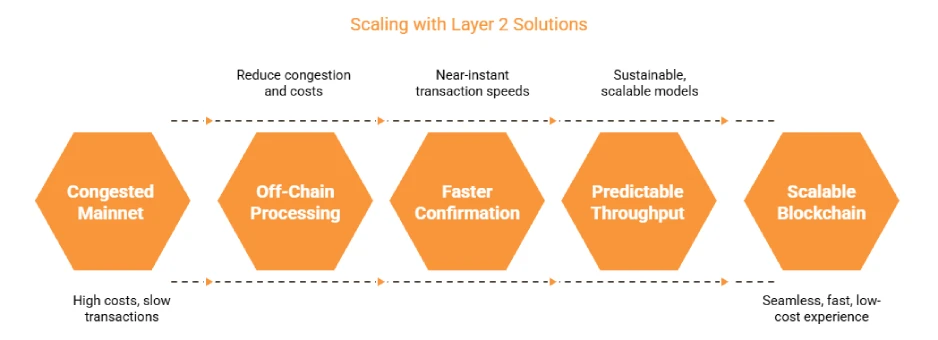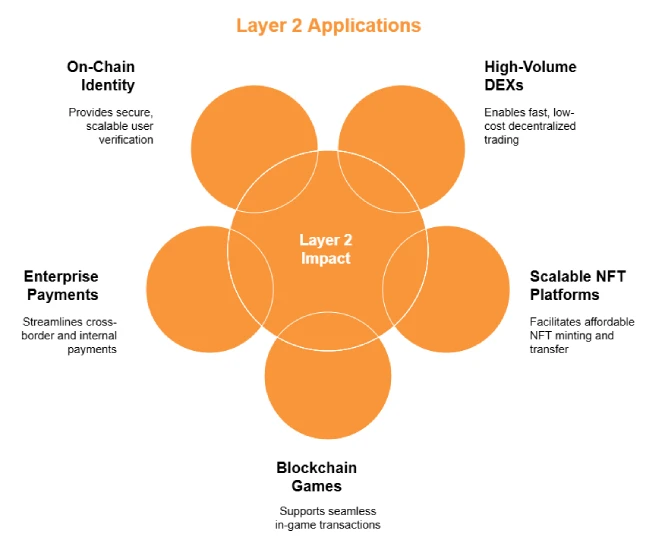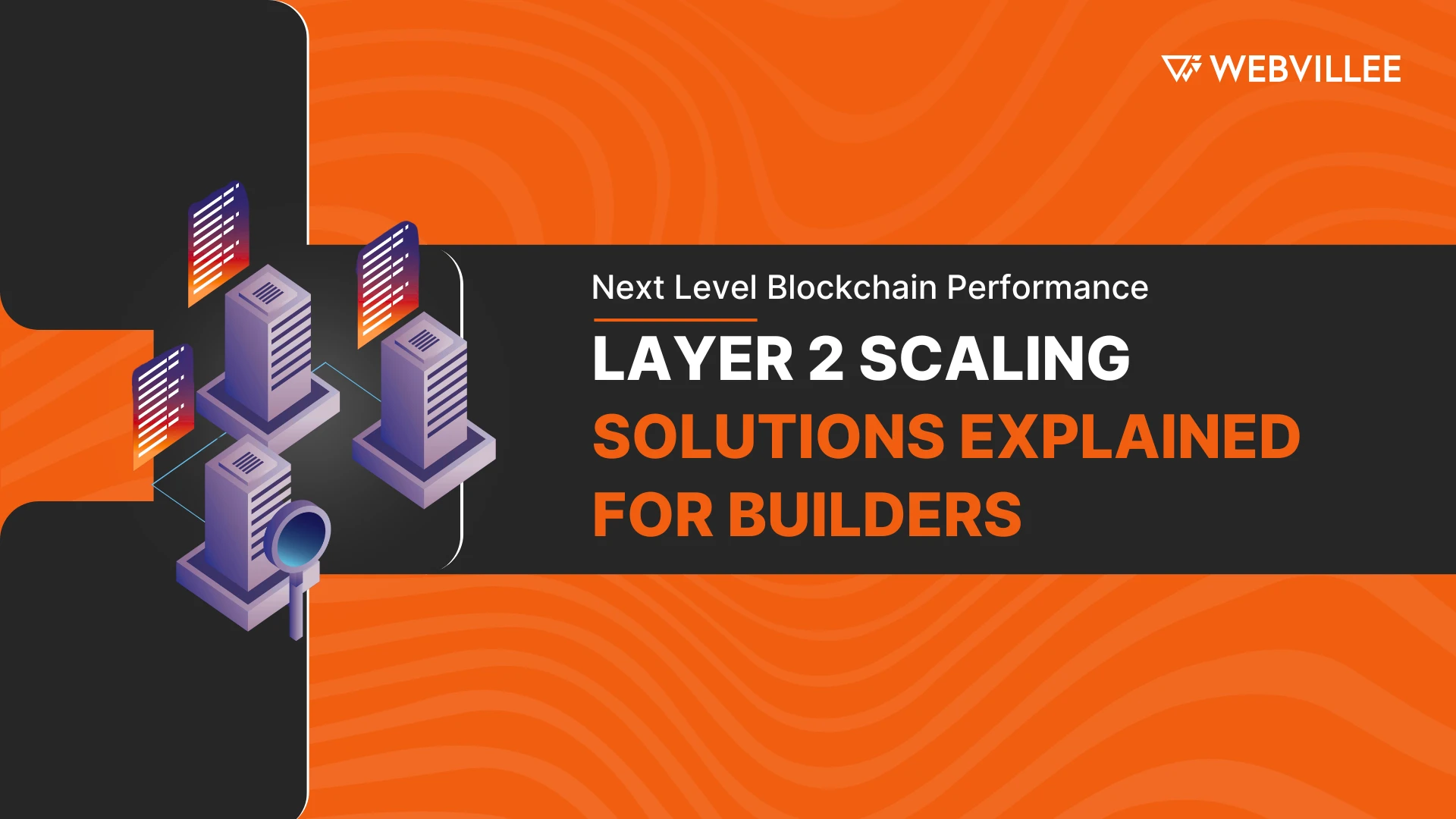Blockchain infrastructure has grown rapidly but not evenly.
While Layer 1 protocols laid the foundation for decentralization, transparency, and immutability, they were never designed to support the sheer scale of modern demand. As usage surged, limitations became clear: high gas fees, network congestion, and delayed transaction finality made mass adoption difficult and user experience inconsistent.
That’s where Layer 2 comes in.
These scaling solutions aren’t just technical enhancements, they’re becoming the infrastructure layer that makes blockchain usable at scale. They offload transactional weight, streamline execution, and bridge the gap between Web3 ideals and Web2 expectations.
In 2025, if you’re building for blockchain, you’re building for Layer 2. Whether it’s for DeFi, gaming, payments, enterprise apps, or tokenized assets, Layer 2 is no longer an option. It’s the operating reality for speed, affordability, and long-term growth.
Let’s break down why that matters, what options are available, and how to make informed, high-impact choices in a maturing, high-stakes ecosystem.
Why Layer 2 Matters Now More Than Ever
Mainnet congestion, rising gas costs, and user drop-offs have made the case clear: Layer 1s can’t scale on their own. While early adopters tolerated delays and high fees, today’s users expect frictionless performance and reliability.
- Users expect Web2-level performance, instant transactions, low latency, and seamless experiences
- Developers need predictable costs to build sustainable models and deploy at scale
- Businesses want blockchain integration without infrastructure headaches or multi-month implementation delays
Layer 2s meet these demands by processing transactions off the main chain and only settling final states on Layer 1. This offloading drastically reduces congestion and costs while preserving decentralization and security.
- For developers and infrastructure teams, this means:
- Lower transaction fees and faster confirmation times
- More predictable throughput and performance benchmarks
- Easier experimentation without risking mainnet instability
Layer 2 isn’t just a performance boost, it’s becoming the default expectation. Builders who adopt Layer 2 infrastructure are positioned to meet modern UX standards while keeping their architecture decentralized and modular.

What Exactly Are Layer 2 Scaling Solutions?
Layer 2 solutions are separate protocols that sit on top of existing blockchains, primarily Ethereum. They handle transactions off-chain or in optimized environments, then anchor the final result to the Layer 1 chain for security and consensus.
There are several types of Layer 2 solutions, each optimized for specific needs:
- Rollups (Optimistic and ZK): Bundle many transactions into one, reducing gas use and increasing throughput
- State Channels: Enable multiple off-chain interactions with only two on-chain transactions (start and end)
- Sidechains: Independent blockchains that interact with the mainnet, often optimized for speed
- Plasma Chains: Use child chains to process transactions and report back to the mainnet
Each of these solutions provides trade-offs between speed, decentralization, security, and developer complexity. But all share the same goal: make blockchain applications scalable enough for real-world usage.
Benefits for Builders in 2025
The Layer 2 landscape has matured rapidly. What was experimental in 2020 is now production-grade in 2025. Builders integrating Layer 2s today get a head start on scalability, speed, and infrastructure resilience.
Here’s what that looks like:
- Reduced Gas Fees: Rollups and other Layer 2 models dramatically reduce the cost of interacting with smart contracts
- Faster Transaction Finality: Builders can offer near-instant user experiences, critical for consumer-facing dApps
- Easier Feature Iteration: With modular designs and scalable logic, developers can iterate faster and safer
- Improved UX: Better performance means fewer drop-offs and more satisfied users
- Compliance & Customization: Sidechains and ZK environments offer paths for regulatory-friendly deployments without compromising decentralization
With robust SDKs, API libraries, and integration support, Layer 2 isn’t just easier to use; it’s becoming unavoidable for teams who want to build beyond MVP.
Use Cases Already Gaining Traction
Layer 2 isn’t a future trend, it’s already a core infrastructure layer for many of the most active and scalable applications in Web3. Builders across industries are using Layer 2 not just to improve performance, but to solve fundamental challenges around cost, speed, and user experience.
Here’s how Layer 2 is already driving real-world impact:
High-Volume Decentralized Exchanges (DEXs)
Platforms like dYdX and Loopring use rollups to process thousands of trades per second with near-zero fees. This makes decentralized trading competitive with centralized platforms without sacrificing security or control.
NFT Platforms with Scalable Minting
Projects like Immutable and Zora integrate Layer 2 to allow creators to mint and transfer NFTs affordably and at scale. Lower transaction costs mean better economics for artists and marketplaces, and smoother UX for collectors.
Blockchain-Powered Games
In-game transactions from asset swaps to micro-payments happen at lightning speed using Layer 2. Games like Gods Unchained leverage Layer 2 to create seamless economies without pricing out players through gas fees.
Enterprise-Grade Payments and Settlements
Businesses are integrating Layer 2 to enable fast, cross-border payments and internal settlements. This lowers transaction friction, improves auditability, and supports real-time financial operations.
On-Chain Identity and Authentication
With Layer 2, decentralized identity frameworks can offer secure, privacy-preserving user verification at scale. This is essential for applications in HR tech, digital onboarding, and Web3 access control.
From DeFi and gaming to logistics, identity, and payments Layer 2 is enabling real applications to scale sustainably, without compromising on decentralization or user experience. It’s not a technical luxury. It’s a competitive necessity.

Choosing the Right Layer 2 for Your Project
Not every Layer 2 is built for the same purpose. Your choice should be driven by how you build, what you’re delivering, and the kind of experience your users expect. A solution that works brilliantly for high-frequency DeFi trading might fall short in an enterprise-grade environment with compliance requirements.
Here’s how to evaluate Layer 2 options through a strategic lens:
Is user experience your top priority?
Consider ZK-Rollups. They offer faster finality and built-in privacy, making them ideal for consumer-facing applications that need performance without compromising data protection.
Are you building something compliance-heavy or regulated?
Look into sidechains. These offer flexibility in governance, privacy, and consensus mechanisms—making it easier to build in jurisdictions where rules evolve quickly.
Do you need speed and agility in development?
State channels can be a strong fit. They support repeated, off-chain interactions and allow for rapid testing and updates without bogging down the base layer.
Are gas costs limiting adoption or experimentation?
Optimistic Rollups are cost-effective and easier to deploy than ZK solutions. While they include a longer challenge period for finality, they work well for non-time-sensitive applications.
Beyond performance and cost, also consider:
- The maturity and documentation of the Layer 2’s tooling
- Community support and long-term ecosystem viability
- How easily it integrates with your preferred Layer 1
- Availability of bridges, developer resources, and analytics
Choosing your Layer 2 is like choosing your cloud stack it’s not about what’s trending, it’s about what aligns with your goals. Rushing into the wrong one can lead to technical debt, user friction, and launch delays.
Think fit, not flash.
How Webvillee Helps Builders Navigate Layer 2
At Webvillee, Layer 2 is more than a technical checkbox; it’s a core part of how we help builders go from idea to infrastructure with confidence.
- We analyze your business logic and recommend the right Layer 2 architecture
- Our teams design modular, API-friendly systems that integrate smoothly with rollups and channels
- We offer full-spectrum support from smart contract development to Layer 1–Layer 2 bridging
- We stay current with the evolving Layer 2 ecosystem, so your build stays ahead of the curve
Whether you’re scaling an MVP or engineering for millions of users, Webvillee helps you build smart, ship fast, and scale without friction.

